Standards Worldwide
Standards Worldwide
Phone +49 30 58885700-07

Standard [CURRENT]
ASTM D 5582:2022
Standard Test Method for Determining Formaldehyde Levels from Wood Products Using a Desiccator
- German title
- Bestimmung der Formaldehydkonzentrationen aus Holzprodukten mit einem Exsikkator
- Publication date
- 2022
- Original language
- English
- Pages
- 8
- Publication date
- 2022
- Original language
- English
- Pages
- 8
- DOI
- https://dx.doi.org/10.1520/D5582-22
Product information on this site:
Quick delivery via download or delivery service
Buy securely with a credit card or pay upon receipt of invoice
All transactions are encrypted
Short description
1.1 This test method covers a small scale procedure for measuring formaldehyde emission potential from wood products under defined test conditions. The formaldehyde level is determined by collecting air-borne formaldehyde in a small distilled water reservoir within a closed desiccator. The quantity of formaldehyde is determined by a modification of the National Institute for Occupational Safety and Health (NIOSH) 3500 chromotropic acid test procedure. Other analytical procedures may be used to determine formaldehyde emission potential provided that such methods give similar results to the chromotropic acid procedure. However, the test results and test report must be properly qualified and the analytical procedure employed must be noted. Procedures based on acetylacetone and pararosaniline have been found to give similar results to chromotropic acid in other test methods used in determining formaldehyde emission potential from wood products (see Test Method E1333 ). 1.2 Wood products typically evaluated by this test method are made with urea-formaldehyde adhesives and include particle-board, hardwood plywood, and medium-density fiberboard. This test method is used for product quality control and is a small bench test method that correlates with the large-scale acceptance test for determining formaldehyde levels from wood products, Test Method E1333 . Alternative conditioning intervals may give better correlation, such as seven day conditioning that parallels Test Method E1333 . The general desiccator testing procedure may be modified for different conditioning times to accommodate its use in manufacturing quality control. However, the test results must be properly qualified and the conditioning time employed must be noted. Note 1: If modifications are made to the conditioning period for quality control purposes, it is important that the modification is consistently applied. Otherwise, the results may not be comparable. 1.3 The values stated in SI units are to be regarded as standard. The values given in parentheses after SI units are provided for information only and are not considered standard. 1.4 This standard does not purport to address all of the safety concerns, if any, associated with its use. It is the responsibility of the user of this standard to establish appropriate safety, health, and environmental practices and determine the applicability of regulatory limitations prior to use. For specific hazard statements, see Section 6 and 8.2.5 . 1.5 This international standard was developed in accordance with internationally recognized principles on standardization established in the Decision on Principles for the Development of International Standards, Guides and Recommendations issued by the World Trade Organization Technical Barriers to Trade (TBT) Committee.
ICS
71.100.50
DOI
https://dx.doi.org/10.1520/D5582-22
Also available in
Loading recommended items...
Loading recommended items...
Loading recommended items...
